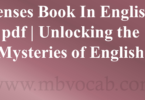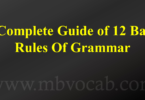Exploring Linguistic Elements: English and Urdu Illustrated
The intricacies and diversities of the English language come to life when we delve into the realms of parts of speech. These fundamental building blocks are essential to constructing coherent sentences, each serving a unique purpose.
In the linguistic tapestry, there exist eight distinctive parts of speech, each endowed with its own character:
- Noun – اسم (Ism)
Definition: A noun is the linguistic lighthouse that guides us to things, people, or places. کسی چیز، جگہ یا شخص کے نام کا کو اسم کہتے ہیں۔ Examples: Tome, Metropolis, Tableau, Rehan Sentences:
- My erudite comrade studies within the hallowed halls of a college.
میرا دوست ایک کالج میں پڑھتا ہے۔ - The voluminous manuscript finds its resting place upon the wooden altar.
کتاب میز پر رکھی گئی ہے۔ - Ali, with his effervescent spirit, engages in the spirited dance with the spherical orb.
علی فٹبال کھیل رہا ہے۔
- Pronoun – اسم ضمیر (Ism-e-Zameer)
Definition: A pronoun, the virtuoso of linguistic substitution, steps in to avoid the monotony of repetition in a sentence. اس کو ہم اسم کے جگہ جملے میں استعمال کرتے ہیں۔ Examples: I, thou, He, She, It, et cetera Sentences:
- He is making his grand entrance in this very moment.
وہ ابھی آرہا ہے۔ - She has graced the gathering with her resplendent attire.
وہ لباس لے آئی ہے۔ - Behold, I cast my gaze upon him.
میں اسے دیکھ رہا ہوں۔
Allow us to present a tableau of Personal Pronouns for your contemplation:
Personal Pronouns of the First Person – صیغہ متکلم
| Number and Gender | Nominative Case | Possessive Case | Objective Case |
|---|---|---|---|
| Singular (masculine and feminine) | I | My, Mine | Me |
| Plural (masculine and feminine) | We | Our, Ours | Us |
Personal Pronouns of the Second Person – صیغہ حاضر
| Number and Gender | Nominative Case | Possessive Case | Objective Case |
|---|---|---|---|
| Singular (masculine and feminine) | Thou | Your, Yours | Thee |
| Plural (masculine and feminine) | You | Your, Yours | You |
Personal Pronouns of the Third Person – صیغہ غائب
| Number and Gender | Nominative Case | Possessive Case | Objective Case |
|---|---|---|---|
| Singular masculine | He | His | Him |
| Singular feminine | She | Her, Hers | Her |
| Singular neuter | It | Its | It |
| Plural common | They | Their, Theirs | Them |
Embark on this linguistic journey, where words unveil their deeper essence, and the extraordinary unfolds within the ordinary.
Exploring Linguistic Aspects: English and Urdu Illustrated
In our linguistic expedition, we continue to unearth the profound intricacies of language, with a focus on verbs and adjectives, two pillars upon which sentences stand tall.
Verb – فعل
Definition: A verb, the catalyst of expression, illuminates the canvas of language by portraying action and state.
یہ حالت کو بیان کرتا ہے یا کسی کام کے ہونے کو۔
Examples: Engage, Peruse, Serenade, Exist, Compose
Sentences:
- He exists within the realm of ailment. (state)
وہ بیمار ہے۔ - Craft a missive addressed to him. (action)
اس کے لئے ایک خط لکھو۔ - Since the afternoon, they have been immersed in the act of play. (action)
وہ دوپہر سے کھیل رہے ہیں۔
Adjective – اسم صفت
Definition: An adjective, the painter’s brush of language, imparts nuanced hues to nouns and pronouns.
یہ اسم یا اسم ضمیر کے بارے میں مزید اضافہ کرتا ہے۔
Examples: Ingenious, Exquisite, Erudite, and more
Sentences:
- This rose exhibits an exquisite beauty. (noun)
یہ گلاب خوبصورت ہے۔ - The fragrance emanating from this blossom is truly captivating. (noun)
یہ گلاب خوشبودار ہے۔ - I harbor an aversion to frigid temperatures. (noun)
مجھے سرد موسم نہیں پسند۔
In our quest to unravel the wonders of language, we’ve explored the depths of verbs and adjectives, where words transform into brushes and paints to craft the canvas of expression.
Adverb – متعلق فعل
In the intricate tapestry of language, adverbs stand as the subtle weavers, adorning verbs, adjectives, and even their own kind with nuanced details of manner, degree, time, or place.
Definition: An adverb is a word that embellishes the meaning of a verb, adjective, or another adverb, frequently delineating the manner, degree, time, or location of an action.
وہ الفاظ جو کسی فعل، اسم صفت یا متعلق فعل کے معنی میں اضافہ کریں، یہ الفاظ اکثر وقت، جگہ، یا کام کے ہونے کے طریقے کو بیان کرتے ہیں۔
Examples: Deliberately, tardily, increasingly, and so on.
Sentences:
- He articulated his thoughts deliberately.
انہوں نے اپنے خیالات کو جان بوجھ کر اظہار کیا۔ - They valiantly engaged in the fierce combat.
وہ دبکی جنگ میں شجاعت سے شامل ہوئے۔ - They are swiftly sprinting towards victory.
وہ جلدی سے کامیابی کی طرف دوڑ رہے ہیں۔
Preposition – حرفِ اضافت یا حرفِ جار
Within the intricate framework of language, prepositions emerge as the connectors, revealing the relationships between nouns or pronouns and the rest of the sentence.
Definition: A preposition is a word that signifies the connection or relation between a noun or pronoun and another element in the sentence.
حرفِ جار ایسا لفظ ہے جو اسم یا اسم ضمیر کا کسی دوسری چیز کے ساتھ تعلق یا رابطہ ظاہر کرتا ہے۔
Examples: From, for, after, on, to, and behind, among others.
Sentences:
- I am en route to Multan.
میں ملتان جا رہا ہوں۔ - My timepiece rests gracefully upon the table.
میری گھڑی میز پر پڑی ہے۔ - They will arrive here at sunset.
وہ یہاں غروبِ آفتاب پر پہنچیں گے۔
Commonly Used Prepositions with Urdu Meanings
Behind – پیچھے
About – کے متعلق
Over – اوپر – پر
Besides – کے علاوہ
Under – نیچے
Beside – ساتھ
At, Into, In – میں
After – کے بعد
With, By – ساتھ
Upon, At, On – پر
For – کے لئے
To – کو
Between, Among – درمیان
Of – کا – کے – کی
From – سے
Language, a tapestry of words, where adverbs add delicate threads of detail, and prepositions connect the dots to form the rich fabric of expression.
Interjection – حرفِ ندا
Within the vast landscape of language, interjections serve as the emotional sparks that ignite expressions of joy, sorrow, or astonishment.
Definition: An interjection is a linguistic vehicle that promptly conveys the abrupt quality or sentiment of the heart, encapsulating emotions of happiness, sorrow, or surprise.
یہ الفاظ فوری جزبے یا دل کے اچانک کیفیت یا احساس کو تسلیم کرتے ہیں۔
Examples: Bravo!, Alas!, Hallelujah!, Silence! and more.
Sentences:
- Bravo! I’ve clinched the coveted first position.
براہو! میں نے پہلی پوزیشن حاصل کی ہے۔ - Alas! I find myself ensnared in failure’s grasp.
افسوس! میں ناکامی کی دائرے میں پھنسا ہوں۔ - Silence! Let not the cacophony of noise prevail.
خاموش! شور وغل روک دو۔
Conjunction – حرفِ عطف
In the intricate mosaic of language, conjunctions are the bridge builders, linking phrases, clauses, or words together into meaningful connections.
Definition: A conjunction is a word that plays the role of a linguistic bridge, joining words, phrases, or succinct clauses together to create coherence.
یہ الفاظ لفظوں یا جملوں کو معنی بنانے کے لئے جوڑتے ہیں۔
Examples: and, or, but, among others.
Sentences:
- I am sipping my coffee, but he grapples with hunger.
میں اپنی کوفی پی رہا ہوں، لیکن اُسے بھوک لگی ہے۔ - You can either indulge in a visual treat or immerse yourself in the pages of a book.
تم جب چاہو کچھ دیکھ سکتے ہو یا کتاب کے صفحات میں غوطہ لگا سکتے ہو۔ - I ventured for a cup of coffee, yet fate intervened as the lights went dim.
میں ایک کپ کوفی کے لئے جا رہا تھا، لیکن قسمت کا کیا ہوا کہ بجلی چلی گئی۔
Language, a diverse tapestry, where interjections convey the heart’s swift sentiments, and conjunctions build bridges that unify the mosaic of expression.







